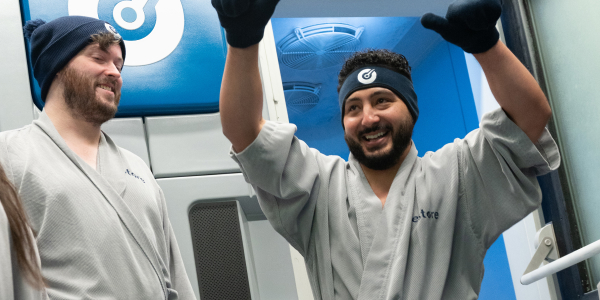Chronic pain is a pervasive issue affecting millions globally. Unlike acute pain, which signals an injury or illness that typically resolves, chronic pain persists for at least 3 months and may last years. In this article, our experts explore chronic pain, common causes, treatments and reasons why you should explore science-backed therapies to help accelerate pain relief.
What is Chronic Pain?
Chronic pain is defined as pain lasting longer than 12 weeks despite treatment or intervention. It can arise from an initial injury, an ongoing cause such as an illness or idiopathic, meaning without a clear reason. Chronic pain affects not only physical well-being but also mental and emotional health, significantly impacting quality of life.
Key Characteristics:
- Duration: Pain persists beyond the typical healing period.
- Intensity: It may range from mild to severe and can be constant or intermittent.
- Impact: Often leads to fatigue, sleep disturbances, and reduced mobility.
Common examples include back pain, arthritis, migraines and neuropathic pain. Understanding chronic pain is the first step toward effective management.
Common Causes
Chronic pain can stem from a variety of sources, each requiring a tailored approach to management.
Musculoskeletal Issues
Conditions like arthritis, fibromyalgia and back injuries are common sources of chronic pain. Degenerative diseases such as osteoarthritis lead to persistent discomfort due to joint wear and tear.
Nerve Damage
Neuropathic pain occurs when nerves are damaged, often described as a burning or shooting sensation. Conditions like diabetes, multiple sclerosis and shingles can result in nerve damage.
Inflammation
Chronic inflammation from autoimmune diseases, such as rheumatoid arthritis and lupus, can cause prolonged pain and swelling in various body parts.
Previous Injuries
Sometimes, pain lingers long after an injury has healed. This can be due to lingering damage or changes in pain processing within the nervous system.
Idiopathic Pain
In many cases, chronic pain has no identifiable cause. Conditions like fibromyalgia present complex symptoms without a clear origin, complicating diagnosis and treatment.
Common Treatments
Managing chronic pain often requires a multifaceted approach. Here are some conventional treatments that can help alleviate symptoms.
Medication
- Nonsteroidal Anti-inflammatory Drugs (NSAIDs): These reduce inflammation and pain but may have side effects with long-term use.
- Opioids: Prescribed for severe pain, these can be effective but carry risks of dependence and side effects.
- Antidepressants and Anticonvulsants: These can be beneficial for neuropathic pain and conditions like fibromyalgia.
Physical Therapy
A personalized exercise regimen can strengthen muscles, improve flexibility and reduce pain. Techniques include manual therapy, aquatic therapy and exercises tailored to individual needs.
Cognitive Behavioral Therapy
Therapy can help patients manage pain by changing the way they perceive and respond to it. This psychological approach can be particularly effective in reducing the impact of chronic pain on mental health.
Lifestyle Modifications
- Diet: Anti-inflammatory foods and maintaining a healthy weight can help reduce pain.
- Exercise: Regular, moderate activity can help improve overall function and reduce pain.
- Sleep Hygiene: Good sleep practices can mitigate the effects of chronic pain.
Complementary Therapies
Acupuncture, chiropractic care and massage therapy can potentially provide relief and help improve mobility. However, working with your healthcare professional for individual recommendations is necessary to avoid exacerbating your condition.
Science-Backed Therapies
Do you feel like you’ve tried it all and still suffer from chronic pain? Science-backed therapies may be able to help.
With more than 225 studio locations nationwide, Restore is committed to democratizing access to the most effective therapies. Professional athletes and celebrities have been using science-backed therapies to accelerate their healing and improve their health, and it’s our goal to ensure that anyone can get access these powerful tools.
Cryotherapy
Cryotherapy involves safely exposing the body to sub-zero temperatures for a few minutes. This can be done with Whole Body Cryotherapy or localized Cryotherapy.
Benefits may include:
- Reduces Inflammation: Cold exposure constricts blood vessels and decreases inflammation, alleviating pain.
- Numbs Nerve Irritation: Cold can temporarily numb painful nerves, providing relief.
- Accelerates Healing: Post-exposure rewarming increases blood flow, promoting faster healing.
CoQ10 IM Shots
Coenzyme Q10 (CoQ10) is a natural antioxidant found in cells, essential for energy production and protecting against cellular damage. CoQ10 injections provide a direct boost to the body’s levels, which can be particularly beneficial for those with chronic pain.
Benefits may include:
- Enhances Cellular Energy: Improved mitochondrial function can reduce fatigue and enhance physical function.
- Reduces Oxidative Stress: CoQ10 mitigates the effects of oxidative stress, which can contribute to pain and inflammation.
- Supports Muscle Function: CoQ10 helps reduce muscle pain and cramps, particularly beneficial for those with fibromyalgia or statin-induced myopathy.
Red Light Therapy
Red Light Therapy uses low-level red to near-red wavelengths of light to penetrate tissues under the skin, stimulating cellular processes that help promote healing and reduce pain.
Benefits may include:
- Reduces Inflammation and Pain: The light energy helps decrease inflammation and pain by modulating immune responses.
- Accelerates Healing: Enhances collagen production and tissue repair, beneficial for joint and muscle pain.
- Improves Circulation: Stimulates blood flow, aiding in the healing of chronic wounds and reducing pain.
Pain Relief is Within Reach
Managing chronic pain is a complex and ongoing process, often requiring a combination of treatments tailored to individual needs. If you've tried pain medications, it may be time to try science-backed therapies like Cryotherapy, CoQ10 IM Shots and Red Light Therapy.
Did you know we offer a 30-Day Wellness Plan for managing chronic pain? Visit your nearest Restore studio and talk to a Wellness Rep about your health goals.
Medical services are provided by an independently-owned physician practice. Some services may require medical clearance and a prescription. We reserve the right to refuse service to anyone. Services, therapies, ingredients and prices may vary per location.
The content on our site, blog posts, educational materials, app, promotional newsletters, and any other written content are not intended to replace an evaluation with a qualified healthcare professional and are not intended as medical advice.




